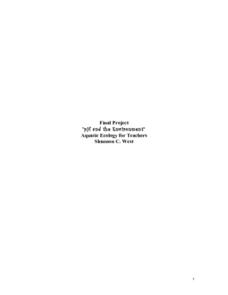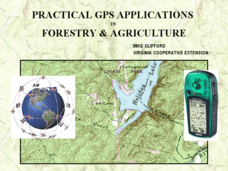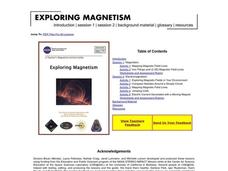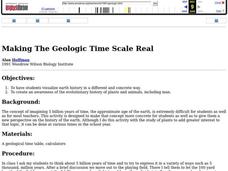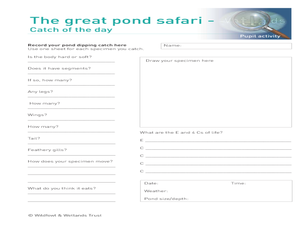Curated OER
Eelgrass Bed Exploration
Students study the function and biological value of eelgrass beds. They discover the habitat requirements of the beds by reading a hand-out and completing a worksheet.
Curated OER
What are Quarters Made of?
Students study the meaning, symbolism, and value of U.S. coins,
especially the quarter. They l research why in 1965 the U.S. Mint decided to
change the metal composition of the quarter to copper coated with zinc. In addition, they...
Curated OER
Mountains in the Sea Exploration No Escape
High schoolers study data to hypothesis about the influence of a water circulation cell on the retention of benthic invertebrate larvae in the area of a seamount. They investigate the positives and negatives of larvae retention in this...
Curated OER
Mud in the Water
Students build a soil erosion model to study the importance of soil conservation. They investigate how land forms from both constructive and destructive forces.
Curated OER
"pH and the Environment"
Eighth graders experiment and study about acids and bases by becoming involved in direct hands-on learning experiences and then relate those experiences to their own lives. They experience the Ohio River and what can be done to help...
Curated OER
All Hands On Deck
Students study estuaries and are able to define one, and describe its features. In this investigative lesson students participate in an activity that shows them the importance of estuaries.
Curated OER
Observing Bursts from an X-ray Burster
Students study the use of X-ray data to make size and energy estimates of the source and the processes occurring there. They use XTE observations of the object GRO 1744-28 to determine whether bursts occur periodically and the duration...
Curated OER
Murder Mystery
High schoolers examine how to capture foot prints while they simulate a criminal investigation. They discover how the clues are needed for identifying or eliminating murder suspects.
Curated OER
Practical GPS Applications in Forestry & Agriculture
An explanation of the Global Positioning System (GPS) and the Geographic Information System (GIS) is given in this presentation. Uses and applications are considered. How it works and sources of error are also touched upon. A large...
Curated OER
Hide and Seek with Geocaching
Students locate objects using a Global Positioning System. In this global geography lesson, students explore latitude and longitude using a GPS in order to locate objects.
Curated OER
Testing the Waters
Eleventh graders examine a local body of water. In this science lesson, 11th graders collect water samples to test. Students analyze the data and make conclusions. Students create tables and graphs of the data.
Curated OER
Exploring Magnetism
Students participate in several activities that allow them to better understand magnetism. In this exploratory lesson students take part in different activities to help them to better understand magnetic fields, circuits and...
Curated OER
Title: Biodiversity Analysis and Comparison Within the New Jersey Highlands
Learners explore the concept of biodiversity. In this environmental science lesson, students use field methods to examine the trophic relationship that allows for species diversity.
Curated OER
Population Dynamics
Students are divided into groups, each group goes to a randomly selected area of the field. They lay out a one square meter plot. Using string to mark the square. Students identify some sort of vegetation that is easy to count within...
Curated OER
Classifying Materials
Students collect data and make observations on how given element samples respond to the field of a magnet and they calculate the density of the samples by finding the mass and volume.
Curated OER
Utilizing Community Resources
Students gain an understanding of scientific methods and use process skills (such as observing, classifying, and predicting) to solve a problem. They develop an understanding of the need for natural preservation.
Curated OER
Biome-Ecology Unit with a "Design a Zoo" Extension
Young scholars participate in a three part unit about biomes. Part one, students research the biomes of North America and part two consists of research on zoos and a field trip to a zoo. While part three ties together the first two...
Curated OER
Making The Geologic Time Scale Real
Students are assigned significant geologic events in Earth's history. They convert the date of the events into distances and then space themselves (on an outside playing field) away from other groups, to represent time between various...
Curated OER
Illnois River and Lake Mussel Habitat Diorama Activity
Learners identify the environmental elements of river and lake mussels. They compare the elements to the time before settlement and during industrialization. They also participate in a field trip to a mussel exhibit.
Curated OER
Investigating Earthquakes: GIS Mapping and Analysis
Pupils describes the technique of preparing "GIS-ready" data and shows how to map that data and conduct basic analyses using a geographic information system (GIS).They use latitude and longitude fields to plot the data in a GIS and...
Curated OER
What is Magnetism?
In this magnetism worksheet, learners review what magnetism is by matching 5 words to their definitions. Then students use a diagram showing the pattern of iron fillings around magnets to complete 4 short answer questions.
Curated OER
Pond Safari
Young scholars investigate organisms and animals by examining a nearby pond. In this ecosystem lesson, students participate in a field trip to a local pond where they utilize a net to gather animals, plants and pollution items, Young...
Curated OER
Clay Hill Animal Sampling
Students create animal print casts from molds in the classroom. They use the cast patterns to identify animal prints on a field trip in which they locate animal tracks, identify the location with GPS and create field casts of the...
Curated OER
Exploring The Neighborhood of the Solar System
Students explain why exploring the universe for life on other planets is an important field of study. They use mathematical formulas to calculate the temperatures of planets as it relates to their distance from the sun. Students use...




